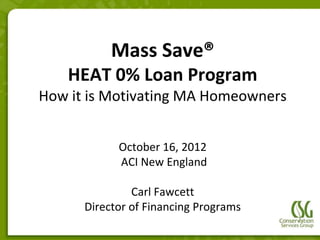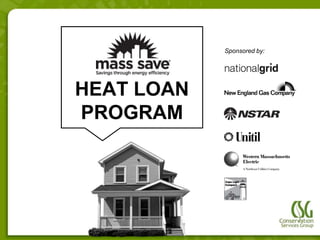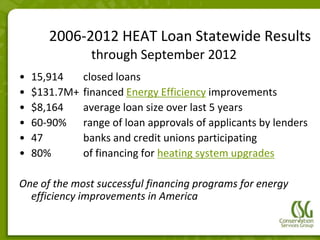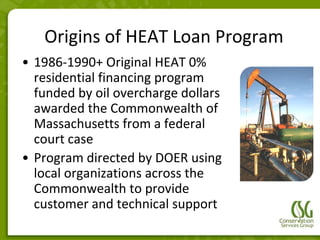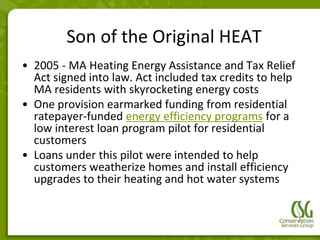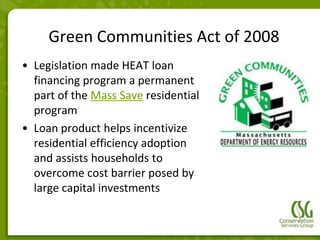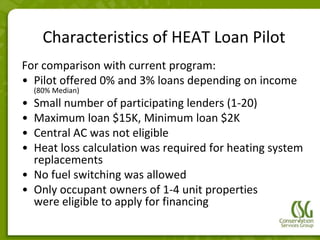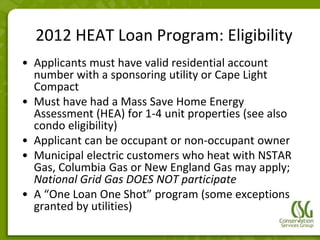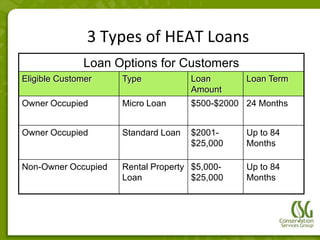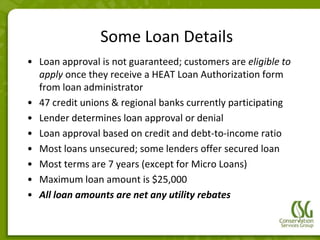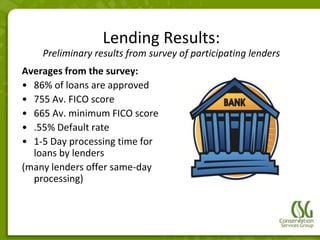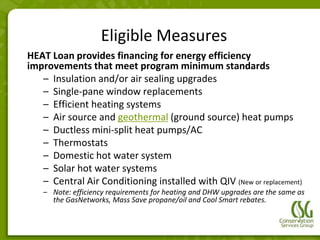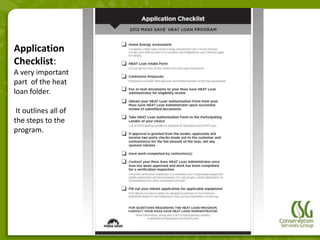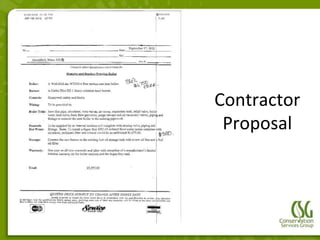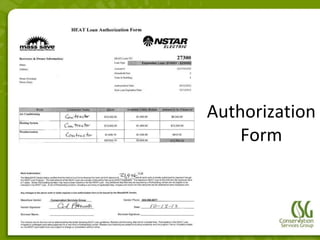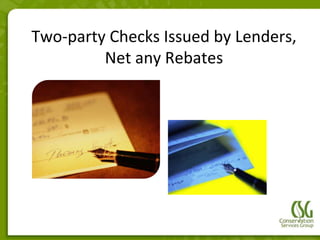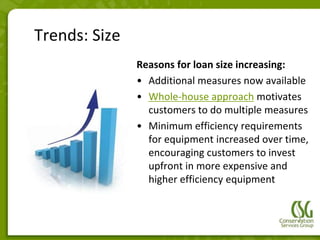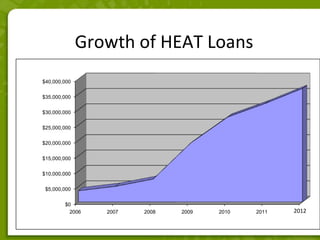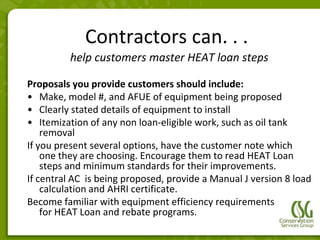Aci mass heat-loan-carlfawcett-csg
- 1. Mass Save® HEAT 0% Loan Program How it is Motivating MA Homeowners October 16, 2012 ACI New England Carl Fawcett Director of Financing Programs
- 3. 2006-2012 HEAT Loan Statewide Results through September 2012 ÔÇó 15,914 closed loans ÔÇó $131.7M+ financed Energy Efficiency improvements ÔÇó $8,164 average loan size over last 5 years ÔÇó 60-90% range of loan approvals of applicants by lenders ÔÇó 47 banks and credit unions participating ÔÇó 80% of financing for heating system upgrades One of the most successful financing programs for energy efficiency improvements in America
- 4. Origins of HEAT Loan Program ÔÇó 1986-1990+ Original HEAT 0% residential financing program funded by oil overcharge dollars awarded the Commonwealth of Massachusetts from a federal court case ÔÇó Program directed by DOER using local organizations across the Commonwealth to provide customer and technical support
- 5. Son of the Original HEAT ÔÇó 2005 - MA Heating Energy Assistance and Tax Relief Act signed into law. Act included tax credits to help MA residents with skyrocketing energy costs ÔÇó One provision earmarked funding from residential ratepayer-funded energy efficiency programs for a low interest loan program pilot for residential customers ÔÇó Loans under this pilot were intended to help customers weatherize homes and install efficiency upgrades to their heating and hot water systems
- 6. HEAT Pilot in 2006 ÔÇó DOER decided the Mass Save residential program would operate this pilot ÔÇó No similar financing program in the U.S. at that time ÔÇó Many program details to work out, including creation of lender network, who would provide customer support, and what measures would be eligible for financing ÔÇó Working group of staff from DOER, participating utilities, and CSG created framework ÔÇó Pilot launched winter 2006
- 7. Green Communities Act of 2008 ÔÇó Legislation made HEAT loan financing program a permanent part of the Mass Save residential program ÔÇó Loan product helps incentivize residential efficiency adoption and assists households to overcome cost barrier posed by large capital investments
- 8. Statewide HEAT Loan Organization Sponsor/Territory Administrative Vendor NSTAR (gas and electric) CSG National Grid (electric only) CSG Cape Light Compact Rise Engineering Western Massachusetts Elec. Honeywell New England Gas Honeywell Fitchburg Gas and Electric Unitil
- 9. Characteristics of HEAT Loan Pilot For comparison with current program: ÔÇó Pilot offered 0% and 3% loans depending on income (80% Median) ÔÇó Small number of participating lenders (1-20) ÔÇó Maximum loan $15K, Minimum loan $2K ÔÇó Central AC was not eligible ÔÇó Heat loss calculation was required for heating system replacements ÔÇó No fuel switching was allowed ÔÇó Only occupant owners of 1-4 unit properties were eligible to apply for financing
- 10. 2012 HEAT Loan Program: Eligibility ÔÇó Applicants must have valid residential account number with a sponsoring utility or Cape Light Compact ÔÇó Must have had a Mass Save Home Energy Assessment (HEA) for 1-4 unit properties (see also condo eligibility) ÔÇó Applicant can be occupant or non-occupant owner ÔÇó Municipal electric customers who heat with NSTAR Gas, Columbia Gas or New England Gas may apply; National Grid Gas DOES NOT participate ÔÇó A ÔÇ£One Loan One ShotÔÇØ program (some exceptions granted by utilities)
- 11. 3 Types of HEAT Loans Loan Options for Customers Eligible Customer Type Loan Loan Term Amount Owner Occupied Micro Loan $500-$2000 24 Months Owner Occupied Standard Loan $2001- Up to 84 $25,000 Months Non-Owner Occupied Rental Property $5,000- Up to 84 Loan $25,000 Months
- 12. Some Loan Details ÔÇó Loan approval is not guaranteed; customers are eligible to apply once they receive a HEAT Loan Authorization form from loan administrator ÔÇó 47 credit unions & regional banks currently participating ÔÇó Lender determines loan approval or denial ÔÇó Loan approval based on credit and debt-to-income ratio ÔÇó Most loans unsecured; some lenders offer secured loan ÔÇó Most terms are 7 years (except for Micro Loans) ÔÇó Maximum loan amount is $25,000 ÔÇó All loan amounts are net any utility rebates
- 13. Lending Results: Preliminary results from survey of participating lenders Averages from the survey: ÔÇó 86% of loans are approved ÔÇó 755 Av. FICO score ÔÇó 665 Av. minimum FICO score ÔÇó .55% Default rate ÔÇó 1-5 Day processing time for loans by lenders (many lenders offer same-day processing)
- 14. As of April 2012: Some Condo Units Eligible for HEAT Loan ÔÇó All residential electric, and natural gas, individually metered condo units may apply ÔÇó Master-metered condos in complexes are NOT eligible ÔÇó Condo complexes that heat with oil or propane, are NOT eligible to participate ÔÇó Lighting and insulation upgrades for condo units are provided by the utilityÔÇÖs multifamily program - treat the whole complex ÔÇó This program addition is a new opportunity for contractors installing heating, hot water and air conditioning systems
- 15. Eligible Measures HEAT Loan provides financing for energy efficiency improvements that meet program minimum standards ÔÇô Insulation and/or air sealing upgrades ÔÇô Single-pane window replacements ÔÇô Efficient heating systems ÔÇô Air source and geothermal (ground source) heat pumps ÔÇô Ductless mini-split heat pumps/AC ÔÇô Thermostats ÔÇô Domestic hot water system ÔÇô Solar hot water systems ÔÇô Central Air Conditioning installed with QIV (New or replacement) ÔÇô Note: efficiency requirements for heating and DHW upgrades are the same as the GasNetworks, Mass Save propane/oil and Cool Smart rebates.
- 16. Measures Financed Since 2006 Heating system & DHW: 11,601 Weatherization: 1,575 Windows: 2,103 Central AC: 228 (6 months)
- 17. Residential HEAT Loan Process (Abbreviated) Customer calls Utility and requests a Mass Save Audit; audit is performed Mass Save Audit verifies CustomerÔÇÖs eligibility to participate in HEAT Loan Customer solicits contractor quotes Program reviews and authorizes proposals; Customer signs check over to Contractor once work completed and passes inspection* Customer receives authorization and receives list of Lenders, applies for Verification Inspection pre-approval Customer closes loan with Lender. Two-party check made in name of Contractor; Lender gives check(s) to Customer
- 18. Application Checklist: A very important part of the heat loan folder. It outlines all of the steps to the program.
- 19. Intake form
- 21. Authorization Form
- 22. Two-party Checks Issued by Lenders, Net any Rebates
- 23. Closed Loans by Year 2010 2011 2012 4500 4000 3500 3000 2009 2500 2000 1500 2006 2007 2008 1000 500 0
- 24. Trends: Volume Volume of loans closed has increased every year ÔÇó Adding new measures such as central AC widens pool ÔÇó Increased marketing by Mass Save utilities and lenders; increase in contractor referrals ÔÇó More word of mouth referrals by customers as program matures ÔÇó Participating customers increase with addition of micro loans and loans for non-occupant owners ÔÇó Large increase in customers participating in the residential efficiency programs in the last 3 years due to program expansion
- 25. Average Loan Size by Year $10,000 $9,000 $8,000 $7,000 $6,000 $5,000 $4,000 $3,000 $2,000 $1,000 $0 $3,649,346 $5,087,889 $7,428,164 $19,095,819 $27,609,119 $31,975,388 $36,877,721 2006 2007 2008 2009 2010 2011 2012 Average loan amount
- 26. Trends: Size Reasons for loan size increasing: ÔÇó Additional measures now available ÔÇó Whole-house approach motivates customers to do multiple measures ÔÇó Minimum efficiency requirements for equipment increased over time, encouraging customers to invest upfront in more expensive and higher efficiency equipment
- 27. Growth of HEAT Loans $40,000,000 $35,000,000 $30,000,000 $25,000,000 $20,000,000 $15,000,000 $10,000,000 $5,000,000 $0 2006 2007 2008 2009 2010 2011 2012 2112
- 28. Contractors can. . . help customers master HEAT loan steps Proposals you provide customers should include: ÔÇó Make, model #, and AFUE of equipment being proposed ÔÇó Clearly stated details of equipment to install ÔÇó Itemization of any non loan-eligible work, such as oil tank removal If you present several options, have the customer note which one they are choosing. Encourage them to read HEAT Loan steps and minimum standards for their improvements. If central AC is being proposed, provide a Manual J version 8 load calculation and AHRI certificate. Become familiar with equipment efficiency requirements for HEAT Loan and rebate programs.
- 29. For Minimum Requirements for Energy Efficient Measures, Steps, and Minimum Efficiency Standards: see MassSave.com/heatloan
- 30. Contact Information: ÔÇó MassSave.com/heatloan ÔÇó HEAT Loan Support Line: 1-800-696-8077 for National Grid and NSTAR territories ÔÇó Fax: 508-836-3181 (CSG) ÔÇó Email: MAHTLoan@CSGRP.Com ÔÇó Carl Fawcett, Director of Financing Programs for CSG: carl.fawcett@csgrp.com or 1-800-696-8077
Editor's Notes
- #4: $131,723,446 - exact # through Sept 2012 of financed Energy Efficiency improvements

